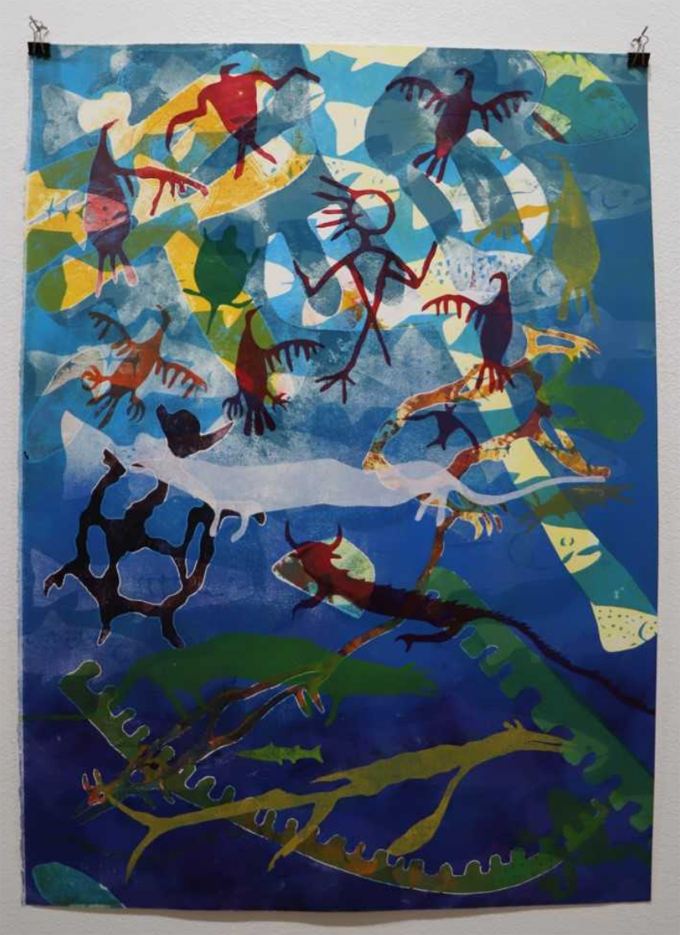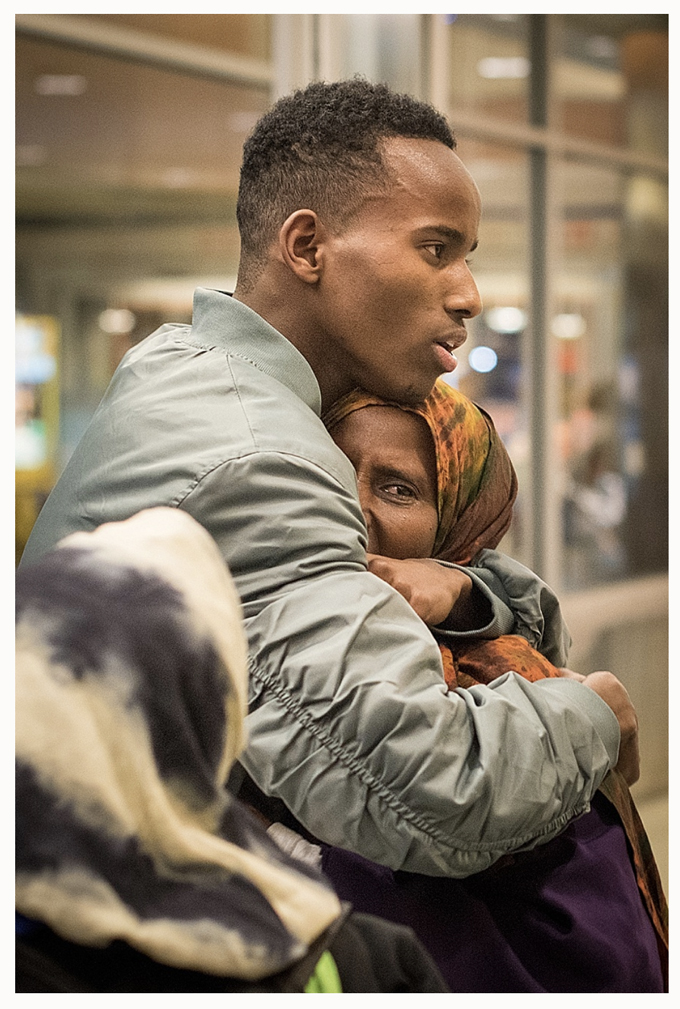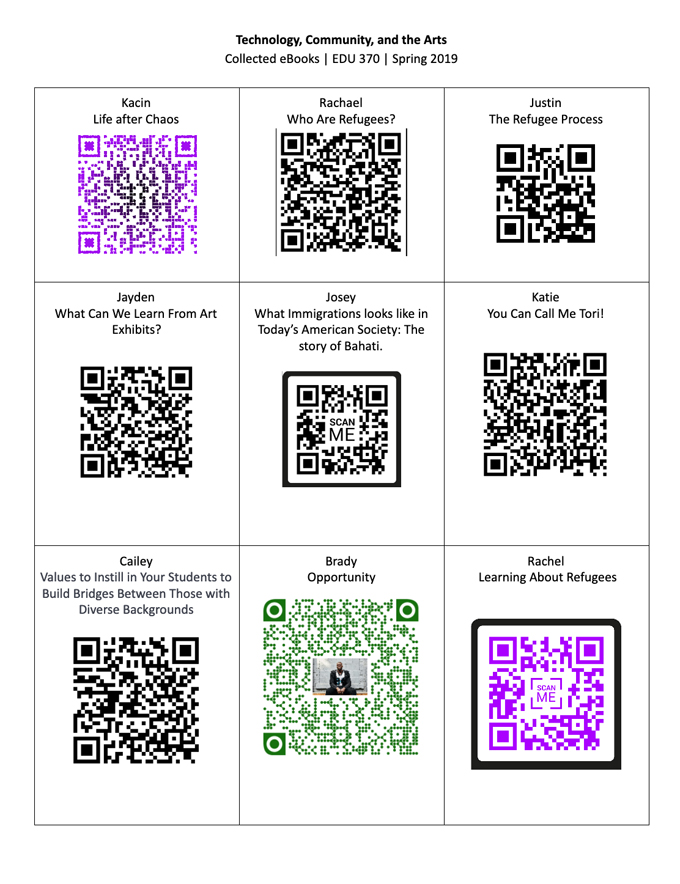Many people find it difficult to engage with—and construct meaning from—an unfamiliar piece of art. Similarly, it can be a challenge to embrace new digital tools and use them to exercise higher level critical thinking skills. Thinking about this complementary puzzle, I wanted to challenge my preservice teachers to use arts and technologies to access complex ideas and think deeply about the choices they make as learners.
As a teacher educator, I want my students to wrestle with the ambiguity of classroom practice, even as many of them demand clear-cut answers for how to teach. Posing this dilemma to Aja Sherrard, the gallerist at our university, we designed a multidisciplinary project that invited students to explore art, create a digital classroom text, and present it at a public open house event.
Watershed
 In the fall of 2018, the University of Montana Western (UMW) hosted an exhibition titled “Watershed” by printermaker Jason Clark, an unregistered member of the Algonquin nation. Clark’s work explores “cultural issues, environmental issues, indigenous mythology and postcolonial identity” through vivid, folkloric imagery. The show’s content is not immediately understood without knowledge of local geography (e.g., the Clark Fork River), current events (specifically, the Dakota Access Pipeline and Standing Rock protests of 2016) and traditional symbols (e.g., thunder birds and water panthers).
In the fall of 2018, the University of Montana Western (UMW) hosted an exhibition titled “Watershed” by printermaker Jason Clark, an unregistered member of the Algonquin nation. Clark’s work explores “cultural issues, environmental issues, indigenous mythology and postcolonial identity” through vivid, folkloric imagery. The show’s content is not immediately understood without knowledge of local geography (e.g., the Clark Fork River), current events (specifically, the Dakota Access Pipeline and Standing Rock protests of 2016) and traditional symbols (e.g., thunder birds and water panthers).
I brought my students to the gallery to meet with Aja, who led us through a guided discussion which included inventorying students’ immediate responses to pieces and the show’s composition as well as making conceptual leaps grounded in visual evidence.
Students were then presented with a challenge: choose a piece of art from the show and create a digital text intended for classroom use. I encouraged them to work at the intersection of arts and technology. How could they use digital tools (iPads, Book Creator, and their own devices) to augment their future students’ understandings? How could their books capture the artist's ideas for those who aren’t able to attend the physical exhibit? In what ways would their book deepen ways of knowing, current events, and empathy?
Students worked on their books over multiple class periods, moving to and from school iPads, their own devices, and the web-based version of Book Creator (an app for making, reading, and sharing interactive books). They captured images, made recordings, and discussed the affordances and constraints of both devices and platforms. They envisioned classroom scenarios, researched, and connected to grade-level standards appropriate for their target classroom. When they finished their digital texts, they published them on Book Creator’s website.
The project didn’t end there, and thankfully so. In the spirit of contributing knowledge to authentic communities, we hosted a public event in the gallery. After publishing their final book, students created a QR code, printed it out, and taped it to the back of their “teacher clipboard.” When we welcomed guests to the event, we encouraged them to use their device’s phone to scan the QR codes and discuss what they read with the author.
The Lucky Ones
 Because I teach on a block schedule, with students taking one course at a time for 18 weekdays, I was able to repeat this project when teaching the course in January 2019. This time, the exhibition in our gallery was Madeline Scott’s “The Lucky Ones,” a collection of photographs that trace the arrival of Syrian refugees to the city of Boise and their subsequent settling into life in the United States. Framing the story in larger political events, key photos featured the last refugees allowed in the country before the so-called “Muslim Bans” went into effect.
Because I teach on a block schedule, with students taking one course at a time for 18 weekdays, I was able to repeat this project when teaching the course in January 2019. This time, the exhibition in our gallery was Madeline Scott’s “The Lucky Ones,” a collection of photographs that trace the arrival of Syrian refugees to the city of Boise and their subsequent settling into life in the United States. Framing the story in larger political events, key photos featured the last refugees allowed in the country before the so-called “Muslim Bans” went into effect.
Like Clark’s show, the exhibit was designed to be more accessible to students. As an introduction to the subject matter, students attended a panel about the growing presence of refugees in Boise. Scott opened the panel, speaking about the experiences and ethical dimensions of photographing such vulnerable moments. The panel included the founder of Soft Landings Missoula, the mayor of Helena who is also a refugee, and the director of the Missoula chapter of the International Rescue Committee.
The students were again prompted to use the exhibit to inspire a classroom-ready digital text. Students leveraged the exhibit’s photographs as launch points for research about the process of coming to the United States as a refugee, the stories of famous refugees, and building classroom cultures that welcome students of all backgrounds. Again, my students used Book Creator to design multimodal texts, publishing the final work as a device-accessible QR code. They presented their final K–8 classroom-oriented digital texts on our final Friday, to the delight of our open house guests. Following are examples of students’ final projects:
Apprenticing into authentic planning practices
 Over the two iterations of this project, my students created digital texts as a way to engage deeply in community-based issues that connected to national political conversations. While making their books, they raised essential teaching questions: who am I speaking to? Why does this matter? Is what I’m sharing accurate (to whom)? What am I trying to accomplish in this lesson?
Over the two iterations of this project, my students created digital texts as a way to engage deeply in community-based issues that connected to national political conversations. While making their books, they raised essential teaching questions: who am I speaking to? Why does this matter? Is what I’m sharing accurate (to whom)? What am I trying to accomplish in this lesson?
Through publishing and speaking to their final texts, this project also provided an intentional apprenticeship into the profession. When the underclassman came to the gallery events, my students reflected with a deep sense of accomplishment about how far along in the program they realized they had come since their own EDU201 days. They saw themselves as stepping into the educational community by publishing in an online space that other educators could access. Finally, by creating a text meant for classroom use and envisioning the scenarios it could support, my preservice students were able to participate in a core practice of classroom teaching.
Katrina Kennett is an assistant professor of education at the University of Montana Western. Her research investigates teachers’ planning practices, specifically how teachers intentionally open opportunities for student inquiry and agency through a variety of technologies. She can be found at @katrinakennett and katrinakennett.com.
This article is part of a series from the International Literacy Association Technology in Literacy Education Special Interest Group (TILE-SIG).